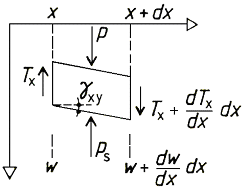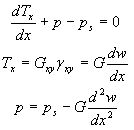MatrixFrame® allows the elastic foundation calculation by Winkler model or by Winkler-Pasternak model.
Winkler model
The analysis of beams bending on an elastic foundation is developed on the assumption that the reaction forces of the foundation are proportional at every point to the deflection of the beam at that point. The vertical deformation characteristics of the foundation are defined by means of identical, independent, closely spaced, discrete and linearly elastic springs. The constant of proportionality of these springs is known as the spring (soil) stiffness coefficient Cz, Cy [kN/m³∙m]. This mechanical representation of elastic foundation was introduced by Winkler:

where:
SoilpressureZ - soil pressure, [kN/m²]
Uz - displacement, [m]
Cz = SoilpressureZ/Uz - spring (soil) stiffness coefficient, [kN/m³∙m]
For 2D plane is used spring (soil) stiffness coefficient Cz by Z axis, for 3D plane - Cz, Cy by Z and Y axes, respectively.
Pasternak model
Another foundation model, proposed by Pasternak, acquires shear interaction between springs. This mathematical model has another constant parameters Cfz, Cfy [kN/m] which characterizes the interaction implied between springs due to friction according to acting transverse shearing.
For the subsoil Pasternak has presented a model with two parameters which are characterized by reaction module k for the absorption capacity of vertical loading, and a module G [N/mm] for the absorption capacity of the shear force.
In his model Pasternak has divided the foundation soil in a top layer for horizontal forces, and a lower layer for vertical forces:


The reaction p of the subsoil on the beam follows from the equation below:

In this equation ps=kw is mentioned before.
The differential equation is going to be:
If:
 and
and ![]()
then:
![]()
![]()
where:
g - shear ratio
In case of a circular plate with axial symmetry the solution is:
![]()
In case of a rectangular plate:

For 2D plane is used spring (soil) stiffness coefficient Cfz by Z axis, for 3D plane - Cfz, Cfy by Z and Y axes, respectively.
Elastic foundation name
Elastic foundation name starts with a default prefix 'E' and followed by a number. Elastic foundation name recording starts with E1, every next elastic foundation will get the next number. The default prefix may be changed in Options preferences.
Elastic foundation calculation models
There are used two elastic foundation calculation models in MatrixFrame®:
-
Linear calculation - without tension elimination by local coordinate system
-
Not linear calculation - with tension elimination by global coordinate system
Elastic foundation constant
Elastic foundation constant may be defined by 3 ways:
-
Cz (spring value for member): by default width value of 1m (NONE)
-
Elastic foundation constant + section width: by entered cross section width (ABSOLUTE)
-
Elastic foundation constant (width from section): by width defined in cross section properties (PROJECTION)
Tapered elastic foundation
For tapered elastic foundation calculation the begin and the end values of spring (soil) stiffness coefficients must be defined - the values should be different.
Unlike other projects MatrixFrame® provides region type elastic foundation (elastic area) for 2D-Plate, 2D-Wall projects.